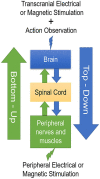Top-down and bottom-up stimulation techniques combined with action observation treatment in stroke rehabilitation: a perspective
- PMID: 37497013
- PMCID: PMC10367110
- DOI: 10.3389/fneur.2023.1156987
Top-down and bottom-up stimulation techniques combined with action observation treatment in stroke rehabilitation: a perspective
Abstract
Stroke is a central nervous system disease that causes structural lesions and functional impairments of the brain, resulting in varying types, and degrees of dysfunction. The bimodal balance-recovery model (interhemispheric competition model and vicariation model) has been proposed as the mechanism of functional recovery after a stroke. We analyzed how combinations of motor observation treatment approaches, transcranial electrical (TES) or magnetic (TMS) stimulation and peripheral electrical (PES) or magnetic (PMS) stimulation techniques can be taken as accessorial physical therapy methods on symptom reduction of stroke patients. We suggest that top-down and bottom-up stimulation techniques combined with action observation treatment synergistically might develop into valuable physical therapy strategies in neurorehabilitation after stroke. We explored how TES or TMS intervention over the contralesional hemisphere or the lesioned hemisphere combined with PES or PMS of the paretic limbs during motor observation followed by action execution have super-additive effects to potentiate the effect of conventional treatment in stroke patients. The proposed paradigm could be an innovative and adjunctive approach to potentiate the effect of conventional rehabilitation treatment, especially for those patients with severe motor deficits.
Keywords: action observation; peripheral electrical stimulation; peripheral magnetic stimulation; transcranial alternating current stimulation; transcranial direct current stimulation; transcranial magnetic stimulation; transcranial random noise stimulation.
Copyright © 2023 Qi, Nitsche, Ren, Wang and Wang.
Conflict of interest statement
MN is member of the scientific advisory board of Neuroelectrics. The remaining authors declare that the research was conducted in the absence of any commercial or financial relationships that could be construed as a potential conflict of interest.
Figures

Similar articles
-
Bilateral Contralaterally Controlled Functional Electrical Stimulation Reveals New Insights Into the Interhemispheric Competition Model in Chronic Stroke.Neurorehabil Neural Repair. 2019 Sep;33(9):707-717. doi: 10.1177/1545968319863709. Epub 2019 Jul 18. Neurorehabil Neural Repair. 2019. PMID: 31315515 Free PMC article. Clinical Trial.
-
Low frequency repetitive transcranial magnetic stimulation to the non-lesioned hemisphere improves paretic arm reach-to-grasp performance after chronic stroke.Disabil Rehabil Assist Technol. 2013 Mar;8(2):121-4. doi: 10.3109/17483107.2012.737136. Epub 2012 Dec 17. Disabil Rehabil Assist Technol. 2013. PMID: 23244391
-
Assessment of inter-hemispheric imbalance using imaging and noninvasive brain stimulation in patients with chronic stroke.Arch Phys Med Rehabil. 2015 Apr;96(4 Suppl):S94-103. doi: 10.1016/j.apmr.2014.07.419. Epub 2014 Sep 3. Arch Phys Med Rehabil. 2015. PMID: 25194451 Free PMC article.
-
A review of transcranial electrical stimulation methods in stroke rehabilitation.Neurol India. 2019 Mar-Apr;67(2):417-423. doi: 10.4103/0028-3886.258057. Neurol India. 2019. PMID: 31085852 Review.
-
Exploring the Prospects of Transcranial Electrical Stimulation (tES) as a Therapeutic Intervention for Post-Stroke Motor Recovery: A Narrative Review.Brain Sci. 2024 Mar 27;14(4):322. doi: 10.3390/brainsci14040322. Brain Sci. 2024. PMID: 38671974 Free PMC article. Review.
Cited by
-
Effects of acupoints-based TENS combined with tDCS on spasticity and motor function in ischemic stroke with spastic hemiplegia: study protocol for a randomized controlled trial.Front Neurol. 2023 Nov 27;14:1269472. doi: 10.3389/fneur.2023.1269472. eCollection 2023. Front Neurol. 2023. PMID: 38090263 Free PMC article.
-
Motor network pre-habilitation by low-frequency repetitive transcranial magnetic stimulation. A proof-of-concept.Acta Neurochir (Wien). 2025 Jul 1;167(1):182. doi: 10.1007/s00701-025-06592-7. Acta Neurochir (Wien). 2025. PMID: 40591056 Free PMC article.
-
Distinct Effects of Brain Activation Using tDCS and Observational Practice: Implications for Motor Rehabilitation.Brain Sci. 2024 Feb 13;14(2):175. doi: 10.3390/brainsci14020175. Brain Sci. 2024. PMID: 38391749 Free PMC article.
-
The Effect of Peripheral Magnetic Stimulation on Functional Mobility and Morphology in Cerebral Palsy with Spastic Diplegia: A Randomized Controlled Trial.Life (Basel). 2025 Mar 7;15(3):416. doi: 10.3390/life15030416. Life (Basel). 2025. PMID: 40141760 Free PMC article.
-
Balance of power: The choice between trial and participant numbers to optimise the detection of phase-dependent effects.Imaging Neurosci (Camb). 2024 Nov 5;2:imag-2-00345. doi: 10.1162/imag_a_00345. eCollection 2024. Imaging Neurosci (Camb). 2024. PMID: 40800470 Free PMC article.
References
-
- Sacco RL, Kasner SE, Broderick JP, Caplan LR, Connors JJ, Culebras A, et al. . An updated definition of stroke for the 21st century: a statement for healthcare professionals from the American Heart Association/American Stroke Association. Stroke. (2013) 44:2064–89. doi: 10.1161/STR.0b013e318296aeca, PMID: - DOI - PMC - PubMed
Publication types
LinkOut - more resources
Full Text Sources

